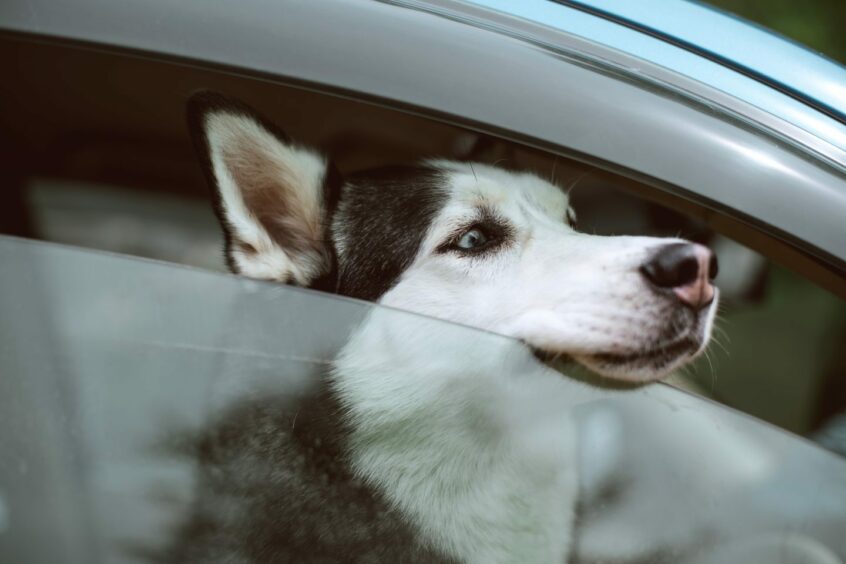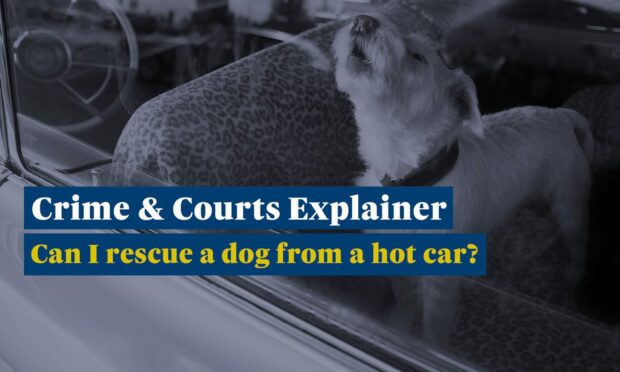The Scottish SPCA says its animal helpline gets more than 200 reports about dogs left in cars on hot days in a typical year.
According to the RSCPA, even when it is only a pleasant 22C outside, a car can reach an unbearable 47C within an hour.
It is not uncommon to hear of dogs dying in such conditions.
So, you see a dog in a car, windows wound up, sun blazing down – is it time to leap into action?

How do we know if a hot dog is in distress?
First question to answer is whether the dog needs help.
Scottish SPCA chief superintendent Mike Flynn explains: “Under no circumstances should a dog be left in a hot car.
“Dogs aren’t able to cool in the same way we are and it only takes a few minutes for the temperature in the car to cause heatstroke and become fatal.
“The most common symptoms of heatstroke are heavy panting, drooling, lethargy, vomiting, drowsiness, collapsing and loss of coordination.
“A dog in a hot car is in serious and immediate danger.
“If you see a dog in this situation, please call Police Scotland on 999.”
But I can break the window?
Not necessarily.
Mr Flynn says anyone who resorts to breaking a dog from a vehicle could face criminal proceedings so it is “essential” to call 999 and not break in if the police can attend.
“We advise taking the names and numbers of any witnesses and to take photos and videos of the dog.
“The dog will need plenty of water to help regulate their body temperature.
“Stay with the dog until help arrives.”
Here comes the legal bit…
Scott Blair, an advocate at the Scottish Bar with a keen interest in animal welfare, says intentionally damaging a car belonging to someone else is, on the face of it, a crime.
Typically damage of this type might be prosecuted as vandalism under section 52 of the Criminal Law (Consolidation) (Scotland) Act 1995 or as the common law offence of malicious mischief.
Under the 1995 Act there is a defence of “reasonable excuse” and case law allows a defence of “reasonable belief of right,” though this might not help much in this scenario.
There may also be a third defence based on necessity.
Mr Blair says if you see a dog in difficulty, legally the safest course of action is to seek help from the police or SSPCA and find out how quickly they can attend.
“If that is not possible or, viewed reasonably, could take too long then in principle, you may be legally entitled to break a window to help the dog either by increasing ventilation or if you are able, to remove the dog.”
It might also be sensible to take photos or video and if possible, take a temperature reading or record a time stamp on any parking tickets displayed in the vehicle.
So there are legal defences for breaking a window to save a dog?
Mr Blair says the “reasonable excuse” defence is a question of fact based on the given circumstances.
The High Court has held for a person to have a reasonable excuse it would have to be “in response to some particular and immediate stimulus.”
One case cited by the court, as an example, was where action was taken in the belief a crime had just been committed and the participants were in the course of escaping.
While it’s not illegal to leave a dog in a car, even with the windows closed, the person responsible could be charged under the Animal Health and Welfare (Scotland) Act 2006 for failing to prevent suffering.
Mr Blair says a reasonable belief an offence might be occurring under sections 19 or 24 of the 2006 Act might afford a reasonable excuse for breaking a window.
- S24 says a person responsible for a dog could be committing an offence the dog’s needs are not met including the need to be protected from suffering, injury or disease.
- S19 says an offence is committed if an animal is caused unnecessary suffering.
The advocate also highlighted another possible defence based on necessity, under common law, to “save life or limb.”
“Given modern conditions and more human attitudes toward animal welfare there may be an argument that the life in question may be canine and not just human.”
He also makes the point the Crown may decide against prosecution as it is arguable whether it is in the public interest to prosecute a dog-saver.
It might also be relevant that damage to the car is usually covered by standard car insurance.
English law can apply too
Mr Blair says section 5 of the Criminal Damage Act 1971 in England also provides examples of “lawful excuse” as a defence against criminal damage accusations.
The advocate, who is also a member of the Scottish Committee of the UK Centre for Animal Law, says although English law, these could be used as potential defences.
Edie Bowles, solicitor at Advocates for Animals which claims to be the first UK law firm dedicated to animal protection, highlights the following examples of lawful excuses:
- If the accused believed the owner of the car would consent if they knew about the circumstances – would the owner rather return to a smashed window or a dead dog?
- If the accused breaks the car window to protect property – including dogs – belonging to themselves or another and they believe the property was in immediate need of protection and the means adopted were reasonable.
Whether ultimately you have a defence to criminal damage is likely to depend on whether you’ve taken reasonable steps and resorted to break in only when there was no other choice.”
— Edie Bowles, solicitor at Advocates for Animals
Ms Bowles also says following the SSPCA advice is the safest legal route though.
Ms Bowles said: “Whether ultimately you have a defence to criminal damage is likely to depend on whether you’ve taken reasonable steps and resorted to break in only when there was no other choice.”
Ms Bowles added: “Don’t accept a caution or feel you need to say anything else until speaking to a solicitor – you may have a complete defence.”
Dogs die on hot walks too
Animal welfare charity Dogs Trust says you should think twice about car trips with your dog and if essential, plan for regular water breaks and try to avoid congested roads.

The charity also says having your car window down is not enough to help your dog and death could come in as little as 20 minutes.
This year, they have expanded their summer safety messaging to highlight dogs can die in other scenarios including on walks.
Keep in mind:
- It’s better to walk your dog at cooler times of the day (early morning or late evening) and not to excessively exercise them, to always carry plenty of water for them and make sure they can cool off in the shade.
- Using a cooling mat or wrapping a frozen water bottle in a tea towel for your pet to lie on, or giving them cold treats from the fridge, are other good ways to keep them cool.
- If necessary, use a pet-safe sun cream on exposed parts of skin and check the temperature of tarmac with your hand before letting your pet walk on it.
- Knowing the early signs of heatstroke – panting, breathing difficulty, tiredness, less keen to play, drooling and vomiting – is vital to taking quick action.
- If you spot these signs, stop exercising your dog and take them into the shade and seek veterinary advice.
- Give your dog a drink of room temperature water, allowing them to drink small amounts
- If your dog is conscious, start pouring small amounts of cool water on to their body and re-apply water regularly until their breathing starts to settle but not so much that they start to shiver.
- Don’t use wet towels as this can restrict air flow and make the dog’s body temperature rise even further.
- If you know your dog has an underlying health condition, take extra care in hot weather or consider skipping walks altogether.











